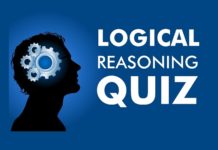REASONING QUIZ
Directions (Q1 to 5): Study the following information carefully to answer the given questions.
Eight people A, B, C, D, E, F, G and H are sitting in a straight line with equal distances between each other, but not necessarily in the same order. Some of them are facing North and some of them are facing south. All have different ages 14, 16, 17, 19, 21, 23, 26, 31, but not in same order.
A sits at one of the extreme ends of the line. Only three people sit between A and G. E sits exactly between A and G. H sits third to the right of E. B is an immediate neighbour of H and faces south. C sits second to the right of F. C is not an immediate neighbour of G. Immediate neighbour of G face opposite directions (i.e. if one neighbour faces North then the other neighbour faces south and Vice-Versa). A and D face the same direction as E (i.e if E faces north then A and D also face North and Vice-Versa). Both the immediate neighbours of E face south. Three people sit between B and 16 yr old. 23 yr old sits immediate left of B. Three persons sit between 26 yr and C. The difference of ages of neighbors of C is 15. Neither B nor C is the youngest. B is elder than C. The difference of ages of neighbors of G is 7.
Q1. In the given arrangement, if three people come and sit to the immediate left of E, how many people will sit between F and C?
(A) Two
(B) Three
(C) Four
(D) More than four
(E) One
Q2. Who amongst the following age is 14?
(A) A
(B) B
(C) Other than those given as options
(D) D
(E) E
Q3. How many people face South as per the given arrangement?
(A) Two
(B) Three
(C) Four
(D) More than four
(E) One
Q4. Four of the following five are alike in a certain way based upon their seating arrangement and so form a group. Which of the following does not belong to the group?
(A) EC
(B) AF
(C) BF
(D) CG
(E) DG
Q5. Who amongst the following sits at the extreme end of the row?
(A) 21 yr old
(B) C
(C) 23 yr old
(D) E
(E) Other than those given as options
Q6. Conclusions:
- Some ducks are rats.
- All cats being duck is a possibility.
Statements:
Statements – 1: No rat is duck. Some ducks are bat. No rat is cat.
Statements – 2: Some rats are ducks. Some ducks are bat. No Cat is duck.
Statements – 3: All rats are ducks. Some ducks are bat. No rat is cat.
Statements – 4: Some rats are ducks. All ducks are bat. No Cat is duck.
Statements – 5: No rat is duck. All ducks are bat. No rat is cat.
(A)Only Statements 1
(B) Both Statements 2 and 3
(C) Only Statements 3
(D) Both Statements 3 and 4
(E) Only Statements 5
Q7. Conclusions:
- Some homes are roses
- Some mugs can be homes
Statements:
Statements – 1: All Mugs are roses. No rose is home. Some homes are rabbits. No rabbit is water
Statements – 2: All Mugs are roses. No mountain is home. Some homes are rabbits. No rabbit is water
Statements – 3: All Mugs are roses. No rose is home. No mountain is home. No rabbit is water
Statements – 4: All Mugs are roses. No rose is home. Some homes are rabbits. All rabbits are water
Statements – 5: All Mugs are roses. Some roses are homes. Some homes are rabbits. No rabbit is water
(A) Only Statements 5
(B) Only Statements 4
(C) Only Statements 3
(D) Only Statements 2
(E) Only Statements 1
Q8. Conclusions:
- All note being metal is a possibility.
- No note is plastic.
Statements:
Statements – 1: Some notes are coin. No coin is plastic. All plastic are metal.
Statements – 2: Some notes are coin. No coin is plastic. Some plastic are metal.
Statements – 3: All notes are coin. No coin is plastic. All plastic are metal
Statements – 4: No note is plastic. Some plastic are coin. All metal are plastic.
Statements – 5: All notes are coin. No coin is plastic. All metal are plastic.
(A) Both statements 3 and 4.
(B) Only statement 2.
(C) Both statements 1 and 5.
(D) Only statement 4.
(E) Only statement 3.
Directions (Q9 to 13): Study the following information carefully and answer the given questions below.
Ten students namely viz P, Q, R, S, T, U, V, W, X and Y of ten different colleges but not necessarily in the same order have exam on five different days starting from Monday to Friday of the same week. Each student have exam at two different time slots, i.e 08.00 AM or 11.00 A.M. Each student have different papers namely – English, Maths, Physics, Chemistry, Biology, Micro Biology, Biotechnology, Commerce, Economics, and Electronics. Only two people have exam between U and Y. Neither T nor V does not have exam on Friday. X has exam on Tuesday at 08.00 A.M. W does not have exam at 11.00 AM. The number of people who have exam between V and S is same as the number of people who have exam between R and W. S does not have exam on any one of the days after T. U does not have exam on any of the days after W. Q has exam immediately before X. X does not have exam on any of the days before V. The one who has exam at 08.00 A.M. Immediately before Y. S has exam immediately after the day of one who has exam on Monday. U does not have exam at 11.00 A.M. Only three people have exam between V and T. The test of Microbiology has scheduled at 8:00A.M. Two persons have exam between the one who has Microbiology exam and the one who has Electronics. The Electronics Test not scheduled on Wednesday. Only one test scheduled between Electronics and Maths. Only two tests scheduled between Commerce and Maths. Economics and Physics scheduled on the same day but neither on Tuesday nor Thursday. Only two tests scheduled between Commerce and Physics. Chemistry and Biology scheduled on the same day. Only two tests scheduled between Chemistry and Biotechnology.
Q9. How many persons have exam at 11’0 clock between T and W?
(A) 5
(B) 6
(C) 2
(D) 4
(E) None of these.
Q10. Who among the following person has exam in English?
(A) Y
(B) W
(C) P
(D) R
(E) S
Q11. Four among the following form a group in a certain way. Which of the following does not belong to Group?
(A) Q – Tuesday
(B) S – Wednesday
(C) V – Tuesday
(D) P – Friday
(E) W – Friday
Q12. Which of the following is correctly matched?
(A) X – Monday – Chemistry
(B) S – Tuesday – Biology
(C) Q – Friday – Physics
(D) V – Tuesday – Electronics
(E) X – Wednesday – Maths
Q13. Who among the following have exam on Friday?
(A) P, Q
(B) R, S
(C) T, V
(D) W, Y
(E) V, X
Directions (Q14-15): In each question below is given a statement followed by two assumptions numbered I and II. An assumption is something supposed or taken for granted. You have to consider the statement and the following assumptions and decide which of the assumptions is implicit in the statement. Give answer
Q14. Statement: “Buy the most contemporary design. That way you’ll be seen driving the latest. And in case you want to sell it, you will always get a good price….” Advertisement of a car.
Assumptions:
- People want to buy those models of cars whose resale value is high.
- The design of a car plays an important role in purchasing it.
(A) If only assumption I is implicit.
(B) If only assumption II is implicit.
(C) If either I or II is implicit.
(D) If neither I nor II is implicit
(E) If both I and II are implicit
Q15. Statement: The dawn of the new millennium could affect computers and computer-run activities.
Assumptions:
- The dawn of the new millennium will be sad for some people.
- The Y2K specialist can solve the problem.
(A) If only assumption I is implicit.
(B) If only assumption II is implicit.
(C) If either I or II is implicit.
(D) If neither I nor II is implicit
(E) If both I and II are implicit
Directions (Q16 to 20): Each of the questions below consists of a question and two statements numbered I and II given below it. You have to decide whether the data provided in the statements are sufficient to answer the question. Read both the statements.
Q16. How is K related to M?
- K is the grandson of M’s father.
- M has no sisters but has several friends and each of his friends is the only son in his respective family.
- If the data in statement I alone are sufficient to answer the question, while the data in statement II alone are not sufficient to answer the question
- If the data in statement II alone are sufficient to answer the question, while the data in statement I alone are not sufficient to answer the question
- If the data either in statement I alone or in statement II alone are sufficient to answer the question
- If the data in both statements I and II together are not sufficient to answer the question
- If the data in both statements I and II together are necessary to answer the question
Q17. How many matches did India win in a series of ten matches against Australia?
- When the fifth match was being played India had won all the previous matches.
- Only one of the matches ended in a draw but the result of the matches played before and after the match drawn were mostly in India’s favour, whereas all the matches played after the seventh match were in India’s favour. Australia also won some matches.
- If the data in statement I alone are sufficient to answer the question, while the data in statement II alone are not sufficient to answer the question
- If the data in statement II alone are sufficient to answer the question, while the data in statement I alone are not sufficient to answer the question
- If the data either in statement I alone or in statement II alone are sufficient to answer the question
- If the data in both statements I and II together are not sufficient to answer the question
- If the data in both statements I and II together are necessary to answer the question
Q18. What is the code for ‘X’ in a code language in which the word ‘MIXER’ is written as ‘>)*=●’
- In the code language STRIP, MAPRO and ASTER are written as ‘=@$●<’
- In the code language MISER is written as ‘>$*=●’
- If the data in statement I alone are sufficient to answer the question, while the data in statement II alone are not sufficient to answer the question
- If the data in statement II alone are sufficient to answer the question, while the data in statement I alone are not sufficient to answer the question
- If the data either in statement I alone or in statement II alone are sufficient to answer the question
- If the data in both statements I and II together are not sufficient to answer the question
- If the data in both statements I and II together are necessary to answer the question
Q19. In which direction was the tourist train ABC running?
- A person ‘Raghu’ sitting in the train saw that his shadow fell exactly on his right. The shadow of his brother ‘Ram’ sitting opposite him fells on his left.
- The train was not moving towards South.
- If the data in statement I alone are sufficient to answer the question, while the data in statement II alone are not sufficient to answer the question
- If the data in statement II alone are sufficient to answer the question, while the data in statement I alone are not sufficient to answer the question
- If the data either in statement I alone or in statement II alone are sufficient to answer the question
- If the data in both statements I and II together are not sufficient to answer the question
- If the data in both statements I and II together are necessary to answer the question
Q20. In which year was Swati born?
- Swati at present is 25 years younger to his mother.
- Swati’s brother, who was born in 1964, is 35 years younger to his mother.
- If the data in statement I alone are sufficient to answer the question, while the data in statement II alone are not sufficient to answer the question
- If the data in statement II alone are sufficient to answer the question, while the data in statement I alone are not sufficient to answer the question
- If the data either in statement I alone or in statement II alone are sufficient to answer the question
- If the data in both statements I and II together are not sufficient to answer the question
- If the data in both statements I and II together are necessary to answer the question
ANSWERS
- C
- C
- B
- C
- C
- C
- A
- E
- C
- B
- E
- B
- D
- E
- D
- D
- D
- C
- D
- E












